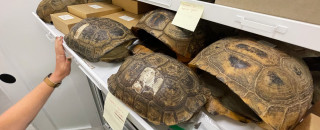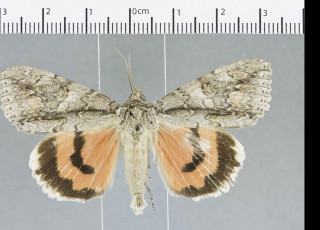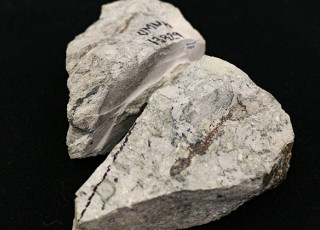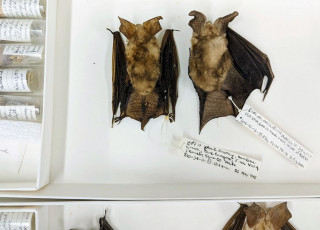Tracking Utah's Nuclear History with a Tortoise Shell
By Mark Johnston
Katrina Derieg, NHMU’s former collections manager of vertebrates, walks a row of tall, white cabinets deep in the Museum’s research wing. Like a librarian with a highly organized Dewey Decimal System, Derieg has memorized the contents of each containing thousands of mammal specimens sorted by taxonomy. Eventually, she pauses to unlock one to reveal a dozen drawers of tortoise and turtle shells. The specimens originate from all around the world, but the one Derieg seeks is from here in Utah, collected on April 23, 1959, from Washington County. To the naked eye, the shell offers little, other than it is indeed a shell in a drawer in a museum. However, to modern-day researchers using techniques unknown in 1959, the shell offers a timestamped record of nuclear history in Utah.
“The specimens aren’t hazardous or radioactive,” says Derieg, while reaching into the cabinet to retrieve the shell. “The team of researchers were looking for isotopic signatures of uranium, but none of the shells are hazardous to handle.”
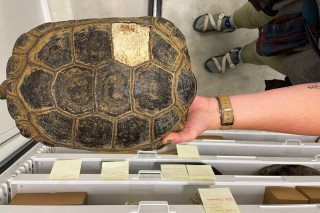
Katrina Derieg holds the tortoise shell with missing scute. Photo by Mark Johnston/NHMU
The researchers she refers to are scientists from the University of New Mexico and Los Alamos National Laboratory, who contacted Derieg in 2021 upon finding a record of the shell online in NHMU’s digitized collections. The specimen was of particular interest to the team given the animal’s presence—while still alive—near a nuclear test site in the 1950s.
Derieg points to where she removed a small square, or “scute,” from the outer layer of the shell, which had previously sat undisturbed in the collections for nearly 65 years. The scute, made of thick layers of keratin, was then sent to the National Laboratory for analysis that would reveal fascinating results in the researchers’ publication.
Why Turtles?
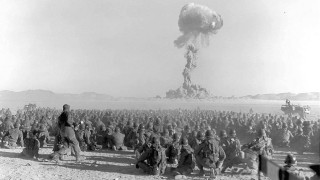
A November 1951 nuclear test at Nevada Test Site.
Image: Public Domain
During the 1950s, the United States embarked on an extensive campaign of uranium enrichment and nuclear testing, conducting numerous detonations to refine their atomic arsenal. One significant testing site was the Enewetak Atoll in the Pacific, where a series of tests took place including the notorious Castle Bravo test in 1954, which resulted in unexpected and extensive fallout. Additionally, the Nevada National Security Site near the Utah border was a critical location for testing. It saw numerous atmospheric and underground tests during this period, contributing to the advancements and understanding of nuclear weaponry, but also raising significant concerns about the environmental and health impacts of these tests on both the affected regions and global population.
While test sites varied in their geography and ecology, there was one thing they had in common: the presence of Chelonians. Chelonians are reptiles of the order Testudines, which include turtles, tortoises, and terrapins. Each has a shell made of bone that is fused to the vertebrae and ribs, and over time the outer plates, or scutes, grow layers of keratin that can absorb environmental contaminants. Absorbtion happens either by direct exposure or by consumption of contaminated food or water, and because the keratin grows in sequential layers over time, the shells offer a time-stamped record of environmental information.
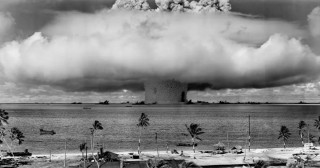
The "Baker" explosion, a nuclear weapon test by the U.S. military at Bikini Atoll, Micronesia, in 1946. Image: Public Domain
“They’re a good proxy to show what [nuclear testing] deposits in the environment; it didn’t happen in a vacuum, and it impacted the environment,” Derieg says.
The research team examined bulk and sequential samples of chelonian scutes from six specimens collected between the 1950s and 1980s near locations of uranium processing, enrichment, weapons testing, and waste disposal, including the Enewetak Atoll and the Nevada Test Site.
Uranium occurs naturally and finding it in turtle shells is not surprising. However, using a technique called “multi-collector inductively coupled plasma mass spectrometry,” the researchers detected isotopes of highly enriched uranium used in nuclear weapons, and the depleted uranium byproduct of enrichment and reactor processes. Both signatures overrode that of naturally occurring uranium found in the specimens, offering unmistakable evidence of anthropogenic radionuclide activity.
Of the six samples collected, bulk samples were taken from five. A fifth sequential specimen was taken from an eastern box turtle, Terrapin carolina, that was collected in 1962 from the Oak Ridge Reservation. The terrapin specimen provided distinct growth layers over seven years of life, enabling the researchers to compare a timeline of the area’s known nuclear events with the uranium signatures recorded in the keratin layers, confirming a chronological record of the site's nuclear history.
The scute delivered from NHMU by Derieg was from a mature Mohave desert tortoise, Gopherus agassizii, from which the researchers conducted bulk scute keratin measurements to determine the presence of anthropogenic uranium. Collected in southwest Utah, the researchers understood that the tortoise had lived far from the Nevada Test Site 150 miles due east. However, this is why their analysis of the shell was so notable, given that the radionuclide data obtained from it accurately reflected low levels of fallout from distant weapons tests which took place throughout 1959.
As reported in the study:
A more subtle isotope signature is present in the Mohave desert tortoise collected in 1959 from the far southwestern region of Utah. It has a slightly enriched 235U/238U ratio coupled with a minor 236U/238U signal. These results are notable, however, given the distance of this location from the (formerly) Nevada Test Site (∼150 miles due east). We note that southwestern Utah did receive nuclear fallout from testing at the NNSS during the 1950s and early 1960s (36). These results suggest that this Mohave desert tortoise accumulated a uranium fallout signature at a considerable distance from a known source of testing.
Research with Natural History Collections
The research team’s publication in PNAS Nexus confirmed that scute materials could be analyzed as inert reservoirs for anthropogenic uranium radionuclides, and the publication received considerable media attention not only for their discovery but due to the convenient timing of their publication near the release of the blockbuster film Oppenheimer.
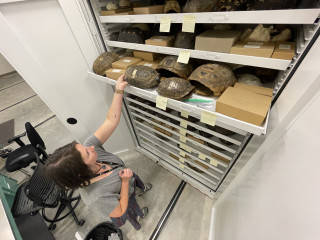
Katrina Derieg retrieves the tortoise shell from a drawer in collections. Photo by Mark Johnston/NHMU
However, what much of the media attention failed to emphasize was the invaluable contributions to the research by museum collections. In fact, all five of the chelonian scute samples analyzed were obtained from natural history collections like those at NHMU. Where else could one find turtle and tortoise shells with accurate data such as date and location of collection?
According to Derieg, a coauthor on the publication, one of the greatest values of museum collections is the sheer number of specimens they contain, spanning more than a century and representing locations all over the world. Millions of specimens in natural history collections worldwide are available for researchers, with a rapidly growing number now available online thanks to collections digitization efforts.
“This is a novel use of collections, and it broadens our view of how collections can be used. And it also increases the value of our specimens because this paper proves how valuable they are to research,” says Derieg, who is often met with surprise from fellow scientists who did not know museum collections are accessible for research. This also underscores the importance of growing and preserving collections in the years to come.
“We’re so glad that people collected these specimens 50 to 100 years ago, and people 50 to 100 years from now will be glad of specimens collected today,” she adds.
To further support this claim, the lead authors of the research publication acknowledged that they worked with a limited sample size and future research can expand the species used to study anthropogenic radionuclides. These might include other organisms such as plants, fish, birds, and other mammals from regions impacted by the nuclear legacy of the United States, some of which already reside in the collections at NHMU and are waiting to be rediscovered.
At this point I wish to emphasize what I believe will ultimately prove to be the greatest value of our museum. This value will not, however, be realized until the lapse of many years, possibly a century, assuming that our material is safely preserved. And this is that the student of the future will have access to the original record of faunal conditions in California and the west, wherever we now work.
